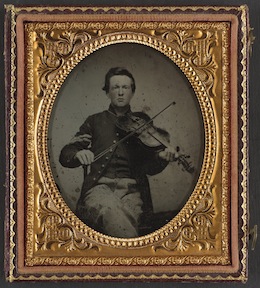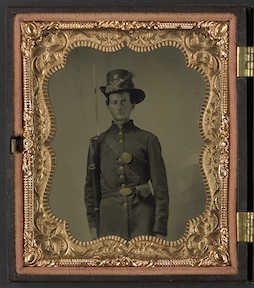I Wish I Had Been in the Case: Portrait Photography, Federal Soldiers, and the Home Circle (part two)

Today, we are pleased to welcome back guest author James Brookes. This is the second part of a two-part series.
The mass transition of images between Federal soldiers and their home communities was entirely unprecedented. In February 1862, Humphrey’s Journal observed “A very large number of soldiers get their ‘pictures’ taken and send them to their friends. Friends at home in return send their portraits… in this way an immense transportation business has been done by the Post Office…” the result being that “Not infrequently a number of bags go out from the Washington office entirely filled with sun pictures”.[xi] George French of the 11th Vermont noted in one letter that he had sent “4 melaintypes” (melainotype being another term for a tintype) home in one week.[xii] Caroline Richards of New York noted in her diary in May 1863 that “Abbie Clark and I had our ambrotypes taken to-day for two young braves who are going to the war.”[xiii] Clearly, the vast movement of these tiny objects of familial intimacy was well-documented by contemporaneous soldiers, civilians and professional photographers.
Considering that the conflict signaled the emergence of dangers that threatened to disable and disfigure the physical appearance of those men who enlisted, the portrait thus provided an important form of self-representation for Federal soldiers. The photographs guaranteed that regardless of the soldier’s fate his past form would be fixed indefinitely.
The photographer James F. Ryder reminisced that in the early days of photography Americans took portraiture very seriously:
It was more the parents having likenesses taken for the children, a matter more seriously considered; something more in the way of duty, possibly a last duty—certainly a sacred one—from parents to children, a legacy of love.[xiv]

If there was a sacred obligation for parents to ensure a portrait was made for their children in times of peace, then such beliefs were only heightened when life and the body were at their most vulnerable. The cultural historian Shirley Samuels notes that portrait photography “left behind an intact body that might be returned to [the family] in pieces.”[xv]
Contemporary fears regarding the elimination of the distinction between men and animals were heightened by the ever-worsening nature of the conflict, as they were simultaneously eroded by the doctrines of nineteenth century science.[xvi] Thus, preserving the human form through a photographic medium such as the tintype portrait became significantly important as the Union demanded greater numbers of men willing to sacrifice their lives in preservation of the nation’s principles and institutions. Considering the significance of the photographic portrait in retaining the full-form of the absent soldier in a conflict pervaded by death, disease and disability, these likenesses permitted the home-circle to visually immortalise their loved ones regardless of their fate.
Once departed, these portraits figured significantly into the personal inventory of the common soldier, providing triggers of memory that would allow them to narrow to the divide between the military and the domestic sphere. One cannot underestimate the importance of a photographic illustration of a member of the home-circle, carried by a departed soldier in the unfamiliar circumstances of military service and war. Owen J. Hopkins of the 182nd Ohio explained “I am too selfish to let anyone look at my Julia’s Photograph. I look at it every night before retiring.” Noting the loss of one such treasured image, he was quick to affirm that “I did not lose yours through neglect. I would have rather lost my musket.”[xvii] The placement of priority on the portrait over his weapon is noteworthy, and the remorse he experienced over the loss of the image is evident. The power of the photographic portrait as a gesture of intimacy and as a coping mechanism for the almost incessant yearning for home is defined by Hopkins.
The letters written by John H. Pardington of the 24th Michigan to his wife, Sarah, contain repeated references to the significance of the portraits they exchanged during the war. In a letter dated the 27th of November, 1862, Pardington admits, “Sometimes I get so lonsome. But I will drive it away again Kiss your picture and Babys and then feel all right. But then it wont Kiss me Back again. So it is not like you for you will kiss me when I kiss you.”[xviii] The portrait had the power to drive away Pardington’s sentiments of solitude but even he admits its limitations. Although it might assuage his yearning for his wife and child for a short time, the images are visual representations and do not return the physical intimacy he smothers them in with his kisses.
Sarah acknowledged the same limitation, as Pardington notes: “You said you kissed it but it did not kiss you back again. I wish I had been in the case. I would have kissed you good.”[xix] Their exchange implies the importance they fix on the photographic portrait as a tangible relic to narrow the divide between their separated spheres. The emotion Pardington experiences when gazing upon the likenesses of his wife and child imply the portrait’s ability to maintain a strong connection with his family, but his desire to be physically transported within a photographic case back to his home illustrates that the image was not all-powerful. In his last letter to Sarah, the photographic portrait made one last evocative and tragic appearance in his writing: “But dear Sarah you are in my thoughts all the time and your Picture I cover with kisses But it wont kiss me Back again. But never mind dear you will kiss me when I get home God Willing wont you.”[xx] Pardington was killed at Gettysburg.

Ultimately, the photographic portrait established itself as a vastly important cultural item to soldiers during the Civil War, allowing authentic likenesses of soldiers and their loved ones to pass with exceptional ease between the separated spheres. Portrait photography had been ingrained into American culture prior to the conflict and with such a significant foundation it is expected that the photographic portrait would figure prominently during the war. The citizens involved in the vast mobilisation of the U.S. Army during the Civil War had nearly two decades to become familiar and acquainted with the portrait photograph; that they featured importantly in the soldier’s personal inventory and on mantles and bedsides across the North is unsurprising. The simplistic, unpretentious images could reassure and comfort soldiers separated from the home communities they were raised in, acting as both a visual and physical fragment of the place they longed for.
The report made regarding the internment of Federal dead into the Gettysburg National Cemetery states that of the twenty deceased soldiers found with photographs on their immediate person, eighteen are carrying only one photograph.[xxi] The importance that soldiers would project onto a single visual portrait of a loved one to when serving in an isolated and detached military organisation where fears of death and disability abound cannot be underestimated. Its existence allowed Federal soldiers of all backgrounds to retain an accurate visual connection to their family members, friends and the domestic sphere for the first time in U.S. military history.
* * *
James Brookes studied American Studies at Great Britain’s Nottingham University as an undergraduate in 2009, spending a year abroad in the U.S. at the College of William and Mary. His undergraduate dissertation was an examination of the importance of the tintype portrait to Civil War soldiers, and his MRes thesis is now expanding on the topic by studying the relation of all forms of portrait photography to Federal soldiers in particular. He plans to write his PhD thesis on various forms (paintings, sketches, cartoons) of visual culture created by the rank-and-file during the war. James has also engaged in Civil War living history in both Europe and the United States, sometimes acting as an assistant to the UK’s only itinerant 19th century historical photographer. Visit his blog, Gone For Soldiers.
* * *
[xi] Charles Seely, ‘Photography in the Army.’, Humphrey’s Journal 13, no. 20 (1862), p. 319, in Janice G. Schimmelman, The Tintype in America, 1856-1880, Transactions of the American Philosophical Society 97, Part 2, (Philadelphia: American Philosophical Society, 2007), p. 55
[xii] George Oscar French, ‘Letter to Friends from Camp Bradley, August 31, 1862’, Vermont Historical Society (http://vermonthistory.org/)
[xiii] Caroline C. R. Clarke, ‘Diary of Caroline Cowles Clarke, May, 1863’, quoted in Village Life in America 1852-1872: Including the Period of the American Civil War as Told in the Diary of a School-Girl, (New York: Henry Holt & Co., 1913), p. 152
[xiv] James F. Ryder, Voigtlander and I in Pursuit of Shadow Catching, (Cleveland, Ohio: Cleveland Printing and Publishing Company, 1902), p. 85, quoted in Carlebach, Working Stiffs, p. 36
[xv] Shirley Samuels, Facing America: Iconography and the Civil War, (New York: Oxford University Press, 2004), p. 74
[xvi] Drew G. Faust, This Republic of Suffering: Death and the American Civil War, (New York: Random House, Inc., 2008), p. XVII
[xvii] Owen Johnston Hopkins in Otto F. Bond ed., Under the Flag of the Nation: Diaries and Letters of Owen Johnston Hopkins, a Yankee Volunteer in the Civil War, (Columbus: Ohio State University Press for the Ohio Historical Society, 1998)
[xviii] John H. Pardington, ‘Letter to Sarah, November 27, 1862’, in Coralou Lassen ed., Dear Sarah: Letters Home from a Soldier of the Iron Brigade, (Bloomington: Indiana University Press, 1999), p. 40
[xix] Pardington, ‘Letter to Sarah, March 30, 1863’, in ibid., p. 91
[xx] Pardington, ‘Letter to Sarah, June 22, 1863’, in ibid., p. 132
[xxi] Revised Report made to the Legislature of Pennsylvania, relative to the Soldiers’ National Cemetery at Gettysburg, (Harrisburg, PA: Singerly & Myers, 1867)
2 Responses to I Wish I Had Been in the Case: Portrait Photography, Federal Soldiers, and the Home Circle (part two)